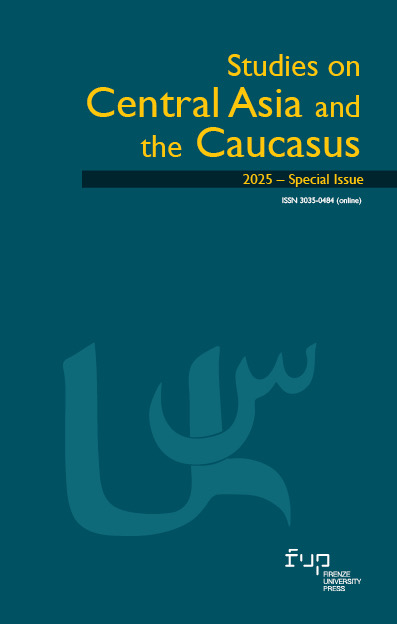Teheran e la nuova geografia della connettività. L’Iran come nodo chiave nelle infrastrutture euroasiatiche
Published 2025-07-04
Keywords
- Iran,
- Silk Road,
- multilateral connectivity,
- infrastructure diplomacy,
- geoeconomics
How to Cite
Abstract
Iran has long played a pivotal role in the economic and commercial networks — and, by extension, in the political relations — that have historically characterized the various branches of the Silk Road. Today, Iran’s geographic centrality, relative stability, and security continue to serve as the cornerstones of its strategic vision to remain a key actor in Eurasian connectivity. The expansion of infrastructure projects, deepening partnerships with Russia and China, and the recent normalization of relations with Saudi Arabia may further consolidate Tehran’s position as a strategic hub between East and West. Nevertheless, significant challenges persist: international sanctions, domestic political volatility, and ongoing regional tensions may hinder the advancement of Iran’s so-called infrastructure diplomacy — a key engine for economic growth and a potential driver of regional stabilization. The Islamic Republic’s ability to balance internal stability, economic development, and foreign policy will be critical in determining the success of its geoeconomic ambitions in the coming decades.
References
- Aarav, Joshi. 2024. “Encircling the Dragon: India’s Strategic Counter to China’s Belt and Road Initiative”, Medium, June 7, 2024. https://india.epochsandechoes.com/encircling-the-dragon-indias-strategic-counter-to-china-s-belt-and-road-initiative-85143e07b870m
- Afrasiabi, Kaveh L., and Nader Entessar. 2018. “The Trump Administration’s Compellence Strategy and Iran’s ‘Melian’ Dilemma.” The Brown Journal of World Affairs 25, no. 1.
- Afrasiabi, Kaveh L., Nader Entessar. 2018. “The Trump Administration’s Compellence Strategy and Iran’s ‘Melian’ Dilemma.” The Brown Journal of World Affairs, 25, no. 1
- Anoop, Singh. 2008. “The Economics of Iran-Pakistan-India Natural Gas Pipeline.” Economic and Political Weekly 43, no. 37: 57-65.
- Bhattacharya, Sumanta et al. 2021. “Can India’s Necklace of Diamonds Strategy Defeat the China’s String of Pearls.” International Journal of Recent Advances in Multidisciplinary Topics 2, no. 11: 105-108.
- Bina, Cyrus. 2017. “Iran’s Oil, the Theory of Rent, and the Long Shadow of History: A Caveat on Oil Contracts in the Islamic Republic.” Revue Internationale Des Études Du Développement, no. 229: 63-90. DOI: https://doi.org/10.3917/ried.229.0063
- Brunelli, Michele, 2015. “Sei giorni con lo Shāh. Un commento alla lettera di un viaggiatore veneziano alla corte di ‘Abbās il Grande”. In Id. (a cura di) Storia Urbana 146, Viaggiatori, mercanti, pellegrini, avventurieri alla scoperta degli spazi asiatici: 115-156. DOI: https://doi.org/10.3280/SU2015-146006
- Dadparvar, Shabnam, Kaleji, Vali. 2024. “The Chabahar Transit Project: Transition from Geo-Politics to Geo-Economics.” Journal of Balkan and Near Eastern Studies, 1-26. DOI: https://doi.org/10.1080/19448953.2023.2233360
- Della Santissima Trinità, Filippo (Philippe de la Très Sainte Trinité, ovvero Julien Esprit). 1670. Viaggi orientali del p. Filippo della SS. Trinità Generale de’ Carmelitani scalzi ne’ quali si descriuono varij successi, molti regni dell’Oriente, monti, mari e fiumi; la successione de’ principi dominanti; i popoli christiani, & infedeli, che stanno in quelle parti. Venezia: Gio. Pietro Brigonci.
- Government of the Islamic Republic of Iran. 2025. “Full text of Iran-Russia Comprehensive Strategic Partnership Agreement.” Government of Iran, January 17, 2025. https://irangov.ir/detail/456479.
- Grigorov, Gavriil. 2025. “Iran Seeks To Expand Nuclear Power Cooperation With Russia’s Rosatom.” The Moscow Time, January 20, 2025. https://www.themoscowtimes.com/2025/01/20/iran-seeks-to-expand-nuclear-power-cooperation-with-russias-rosatom-a87669.
- Kennedy, Charles. 2024. “Iran’s President Hails Long-Term Natural Gas Deal With Russia.” Oilprice, October 1, 2024. https://oilprice.com/Latest-Energy-News/World-News/Irans-President-Hails-Long-Term-Natural-Gas-Deal-With-Russia.html.
- Khan, Aslam. Sandeep Singh, Bawa Singh, Amandeep Kaur. 2023. India’s Energy Diplomacy in Eurasia Geopolitical and Geo-economic Perspectives, London: Palgrave Macmillan. DOI: https://doi.org/10.1007/978-981-99-8281-3
- Lu, Yang. 2016. China-India Relations in the Contemporary World Dynamics of National Identity and Interest. New York: Taylor and Francis.
- Martini, Fulvio. 1999. Nome in codice Ulisse. Trent’anni di storia italiana nelle memorie di un protagonista dei servizi segreti, Milano: Rizzoli.
- Pompeo, Michael R. 2018. “Confronting Iran: The Trump Administration’s Strategy.” Foreign Affairs 97, no. 6: 60-71.
- Shambayati, Hootan. 1994. “The Rentier State, Interest Groups, and the Paradox of Autonomy: State and Business in Turkey and Iran.” Comparative Politics, 26, no. 3: 307-331. DOI: https://doi.org/10.2307/422114
- Smith, Jeff. 2018. “China’s Belt and Road Initiative: Strategic Implications and International Opposition.” The Heritage Foundation, August 9, 2018.
- The Business Time. 2024. “Saudi Arabia’s Vision 2030 projects reach US$1.3 trillion in value.” The Businness Time, September 10, 2024. https://www.businesstimes.com.sg/property/saudi-arabias-vision-2030-projects-reach-us1-3-trillion-value.
- White House, The. 2018. “President Donald J. Trump is Ending United States Participation in an Unacceptable Iran Deal.” National security Archives, The White House, May 8, 2018. https://trumpwhitehouse.archives.gov/briefings-statements/president-donald-j-trump-ending-united-states-participation-unacceptable-iran-deal/.
- White House, The. 2025. “Fact Sheet: President Donald J. Trump Restores Maximum Pressure on Iran.” The White House, February 4, 2025; https://www.whitehouse.gov/fact-sheets/2025/02/fact-sheet-president-donald-j-trump-restores-maximum-pressure-on-iran/.
- World Bank. 2025. “Afghanistan: Economy Shows Modest Growth After Two Years of Severe Contraction, But Recovery Remains Fragile.” The World Bank, December 4, 2025.
- Zahid, Asghar et al. 2007. “Iran-Pakistan-India Gas Pipeline – An Economic Analysis in a Game Theoretic Framework [with Comments].” The Pakistan Development Review 46, no. 4: 537-550. DOI: https://doi.org/10.30541/v46i4IIpp.537-550

